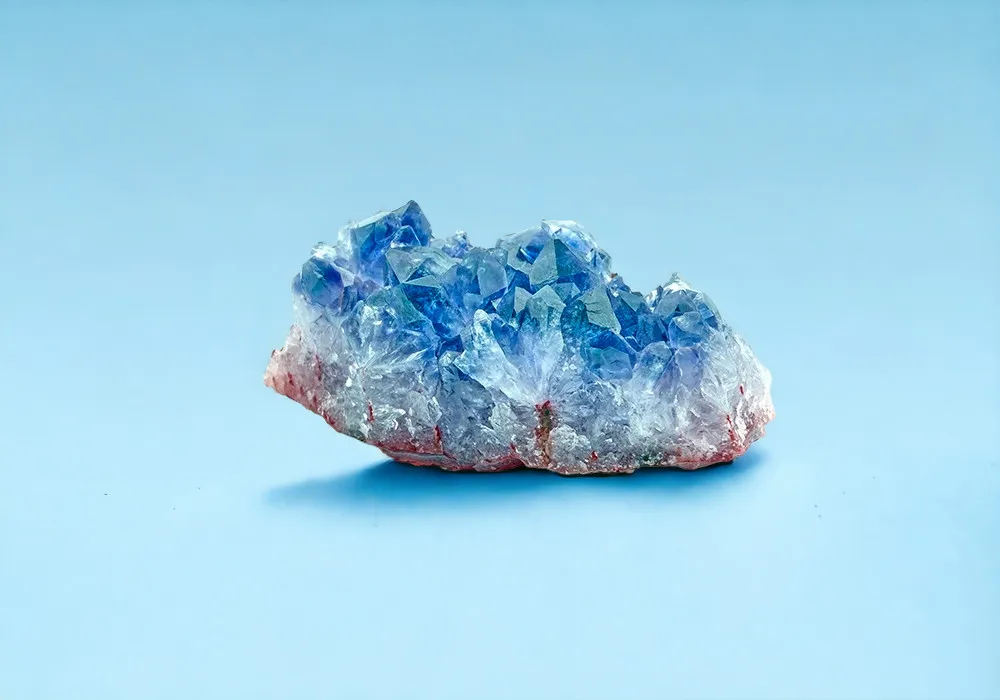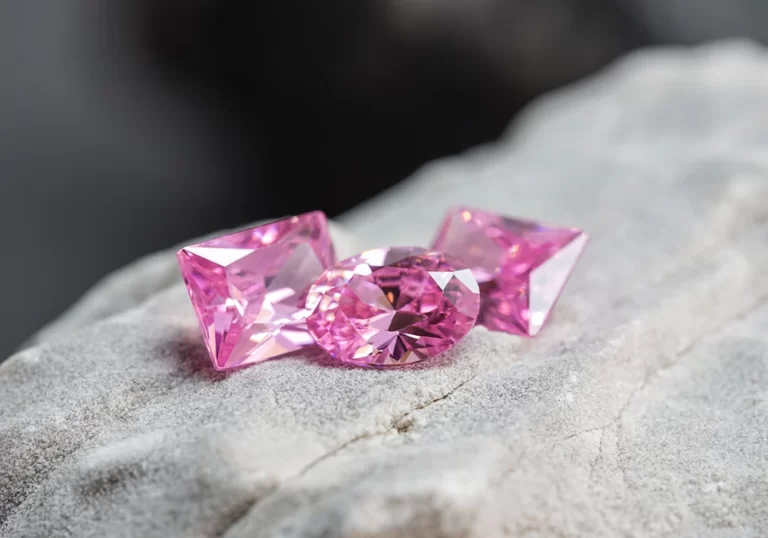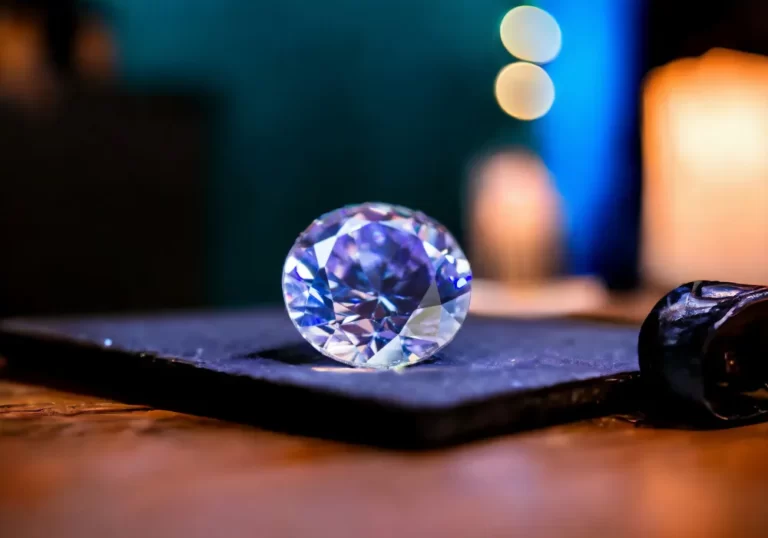Blue amethyst is a precious gemstone highly valued for its beauty and potent properties. With its captivating shades of blue and a rich history steeped in healing capabilities, blue amethyst is a gemstone to dig into.
In this section, we will take you on a journey into the world of blue amethyst, where we will explore its unique features and marvel at its numerous wonders. Whether you admire gemstones or are intrigued by their allure, this article promises to offer valuable insights and information about one of the most extraordinary and sought-after gems in existence.
Key Points
- Blue amethyst is a rare gemstone highly valued for its unique beauty and properties.
- It comes in a range of alluring shades of blue and has a rich history steeped in cultural significance.
- Blue amethyst is believed to have healing properties that benefit the body and mind.
- It is a gemstone that requires special care to maintain its vibrancy and energy.
- Blue amethyst can be used to create stunning jewelry pieces that showcase its beauty and charisma.

The Alluring Hues of Blue Amethyst
Blue amethyst is a captivating gemstone highly valued for its beauty and rarity. What makes it so enchanting is the range of blue hues it displays, from delicate pale blues resembling a clear sky to deep violet-blue tones that inspire deep reflection. These beautiful shades result from iron and other trace elements in the quartz crystal, which give amethyst its unique and alluring color properties.
The spectrum of blue in amethyst can vary from a gentle baby blue evoking fond memories of a serene sky to a rich midnight blue that encourages contemplation. Some blue amethyst stones even possess a green undertone, adding an extra layer of charm and intrigue.
One of the fascinating aspects of blue amethyst is that no two stones are exactly alike. Each stone possesses its distinct hue, making it even more prized and sought after by gemstone collectors, artisans, and enthusiasts.
“Blue amethyst is truly a one-of-a-kind gemstone. Its hues and shades are breathtaking, making it a must-have for any gemstone collection.”
Exploring the Color Properties of Blue Amethyst
The color of blue amethyst is influenced by several factors, including the location where it was mined and the temperature and pressure conditions it was exposed to during formation. Iron and other trace elements also contribute to the blue hues. Generally, deeper shades of blue are formed in areas with higher iron concentrations.
Interestingly, the color of blue amethyst can also change over time due to exposure to light and heat. This makes it essential to carefully handle and store blue amethyst to maintain its color and value.
Blue Amethyst and Other Blue Gemstones: Comparing Hues
| Gemstone Name | Shade of Blue | Other Colors Present |
|---|---|---|
| Blue Topaz | Light Blue | Clear, White |
| Aquamarine | Light Blue | Green, Yellow |
| Blue Sapphire | Deep Blue | Yellow, Green |
| Blue Zircon | Medium Blue | Green, Yellow |
While the shades of blue in blue amethyst are genuinely unique, comparing them to other blue gemstones can provide valuable insights into the color properties of these stones. As seen in the table above, blue topaz and aquamarine have a lighter shade of blue than blue amethyst, while blue sapphire and blue zircon have more profound, more intense blue hues.
Despite the differences, each of these gemstones is prized for their unique beauty and properties, making them stand out in any collection.
Overall, blue amethyst is a rare gemstone that entices with its rich and dynamic color properties. Whether you are a collector, artisan, or enthusiast, this stone is one to explore and add to your gemstone collection.
A Rich History of Blue Amethyst
Blue amethyst is a rare and coveted gemstone that has intrigued people for centuries, with a rich history dating back to ancient times. The name “amethyst” comes from the Greek word “amethystos,” meaning “not drunken,” as it was believed to prevent drunkenness.
In ancient Greek and Roman cultures, blue amethyst was considered a symbol of royalty and was often used in crowns and jewelry worn by monarchs and other high-ranking officials. It was also believed to have mystical and spiritual qualities that could protect against negative energy and offer clarity of thought.
“The ancient Greeks wore amethyst and made drinking vessels decorated with it in the belief that it would prevent intoxication.”– Gemological Institute of America
During the Middle Ages, blue amethyst was used in religious jewelry and was highly valued by the Catholic Church. The gemstone was believed to have healing powers and was often used in religious ceremonies to help ease the pain of physical and emotional ailments.
Today, blue amethyst remains a popular gemstone for jewelry and is highly prized for its unique beauty and rarity. It is often used in engagement rings, necklaces, and earrings and is a favorite of collectors and gemstone enthusiasts.

The Healing Properties of Blue Amethyst
Blue amethyst not only possesses exquisite beauty but also holds significant healing properties. Its energy exudes a soothing and refreshing aura, bringing equilibrium and inner tranquility.
In terms of well-being, blue amethyst is believed to assist with various ailments. It alleviates respiratory and digestive issues and relieves headaches and inflammation. Moreover, blue amethyst is reputed to support sleep patterns, making it a popular choice for individuals grappling with insomnia or other sleep disorders.
Metaphysically speaking, blue amethyst is closely associated with the eye chakra—an energy center responsible for intuition, insight, and spiritual awareness. When incorporated into meditation or spiritual practices, blue amethyst can. Nurturing this chakra leads to an enhanced connection with the divine and a deeper understanding of oneself and the universe.
To harness the metaphysical benefits of blue amethyst, it is advisable to wear it as jewelry or keep it close by in a pocket or pouch. Placing it within your living space or workspace can foster serenity and well-being.
Where Blue Amethyst is Found: Sources and Rarity
Raw Blue Amethyst is a rare gemstone with stunning shades of blue, ranging from pale lilac to deep violet-blue. While Amethyst is found worldwide, blue amethyst is particularly rare and highly coveted.
The primary source of blue amethyst found is in the Artigas region in Uruguay, where mining occurs in underground deposits. Here, miners extract the gemstone from volcanic rock, then cut and polish it into magnificent gemstones.
Other sources of blue amethyst include Zambia, Brazil, Madagascar, and Sri Lanka, although these deposits are much smaller than the Artigas region. Additionally, natural blue amethyst is exceptionally rare, and most gemstones on the market are treated with heat or irradiation to enhance their blue color.
| Location | Rarity |
|---|---|
| Artigas, Uruguay | Primary Source |
| Zambia | Small Deposits |
| Brazil | Small Deposits |
| Madagascar | Small Deposits |
Due to its rarity and unique beauty, blue amethyst is a highly sought-after gemstone that has been known to command high prices at auction. As such, it is often used in high-end jewelry designs and is particularly popular among collectors and gemstone enthusiasts.
In conclusion, while blue amethyst can be found in various parts of the world, it remains a rare and highly coveted gemstone. Its unique color properties and rich history make it a valuable addition to any gemstone collection.

Creating Stunning Blue Amethyst Jewelry
If you’re interested in adding a touch of enchanting beauty to your jewelry collection then blue amethyst is the gemstone for you. With its captivating blend of purple shades this gemstone is highly sought after for creating exquisite jewelry designs.
One way to incorporate amethyst into your jewelry is by featuring it as the focal point of a necklace or pendant. Its distinct color properties make it a captivating centerpiece that can be combined with gemstones or metals to craft a truly distinctive piece.
Another option is to include amethyst in earrings or bracelets. The gentle blue tones can bring an air of elegance to any ensemble and the gemstones durability ensures it can be worn daily.
When utilizing amethyst in jewelry making it’s crucial to consider the cut and clarity of the stone. A cut gem will showcase its vibrant color and enhance its brilliance and sparkle. Moreover clarity plays a role, with blue amethyst since any imperfections or inclusions can impact its overall visual allure.
Blue Amethyst Jewelry Examples
| Blue Amethyst Jewelry Type | Description |
|---|---|
| Blue Amethyst Pendant | A stunning, deep blue amethyst stone set in a silver pendant with intricate detailing. |
| Blue Amethyst Earrings | Oval-shaped blue amethyst stones set in yellow gold earrings, perfect for a formal occasion. |
| Blue Amethyst Bracelet | A delicate bracelet featuring several small, round blue amethyst stones set in a silver band. |
No matter how you choose to use blue amethyst in your jewelry, this gemstone is sure to add a touch of sophistication and allure to any design.
Blue Amethyst and Chakras
Blue amethyst is not only a beautiful gemstone but also has powerful healing properties that make it an excellent tool for balancing and activating the chakras. Specifically, blue amethyst is associated with the third eye chakra, which is located in the center of the forehead.
The third eye chakra is responsible for intuition, insight, and spiritual awareness. When this chakra is blocked or imbalanced, it can result in a lack of clarity, confusion, and an inability to trust one’s inner wisdom. Blue amethyst helps to clear and activate the third eye chakra, enhancing one’s intuition and ability to connect with the spiritual realm.
Metaphysically, blue amethyst is believed to provide a calming and soothing energy that helps to alleviate stress and promote tranquility. It is also thought to enhance communication and self-expression, making it an excellent tool for those who struggle with speaking their truth.
Using Blue Amethyst for Chakra Healing
There are various ways to use blue amethyst for chakra healing. One popular method is to meditate with a blue amethyst crystal placed on the third eye chakra. This can help to clear and activate the chakra, promoting clarity and spiritual awareness.
Another way to use blue amethyst is to wear it as jewelry. This allows the gemstone to remain in constant contact with the skin, providing a continuous flow of healing energy throughout the day. Blue amethyst can be incorporated into necklaces, bracelets, earrings, and other pieces of jewelry.

Caring for Blue Amethyst
To ensure that blue amethyst remains effective in healing chakras and maintains its energy it’s important to take proper care of it. This involves cleansing the gemstone using methods like placing it in sunlight or moonlight smudging it with sage or palo santo or putting it on a bed of sea salt.
It’s also advisable to avoid exposing amethyst to extreme temperatures or harsh chemicals as they can cause damage to the gemstone. When not, in use storing amethyst in a protective pouch or container is recommended to prevent any scratches or potential damage.
Cleansing
Regularly cleansing your blue amethyst is essential to remove any negative energy it may have absorbed. You can cleanse your blue amethyst using any of the following methods:
- Saltwater: Soak your blue amethyst in a bowl of saltwater for several hours and then rinse it with warm water.
- Smudging: Pass your blue amethyst through the smoke of burning sage or palo santo to remove negative energy.
- Moonlight: Place your blue amethyst under the light of the full moon to cleanse and recharge its energy.
Maintaining Its Energy
Blue amethyst is believed to have powerful healing properties, and to maintain its energy, it’s important to avoid exposing it to harsh chemicals or extreme temperatures. You can also keep your blue amethyst energized by:
- Wearing it frequently or keeping it close to your body in a pocket or purse.
- Placing it on a crystal cluster or selenite charging plate for several hours to recharge its energy.
- Using it during meditation or energy healing practices to enhance its energy and promote healing.
By following these simple care and maintenance steps, you can ensure that your blue amethyst remains a treasured gemstone for years to come.

Conclusion
As we come to the end of our journey into the world of amethyst it’s evident that this exceptional gemstone is a true marvel worth exploring. From its captivating shades of blue to its historical background and therapeutic qualities blue amethyst enthralls our senses and brings numerous benefits.
Whether you’re a crafting exquisite jewelry or simply intrigued by the metaphysical aspects of gemstones choosing blue amethyst is an excellent decision. Moreover due to its rarity in the realm of gemstones owning a piece of amethyst offers a distinctive and precious experience.

Remember to care for your amethyst diligently employing gentle cleansing techniques in order to preserve its vibrant energy. With its enchanting beauty and enigmatic allure blue amethyst is genuinely a gemstone that should be cherished and savored, for years to come.
FAQ
What is blue amethyst?
Blue amethyst is a rare gemstone that exhibits stunning shades of blue. It is a variation of amethyst, a purple quartz, and gets its blue color from the presence of trace elements and irradiation.
Where can I find blue amethyst?
Blue amethyst can be found in various locations around the world, including Uruguay, Brazil, and Namibia. However, due to its rarity, it may not be readily available in all jewelry stores or gemstone markets.

What are the healing properties of blue amethyst?
Blue amethyst is believed to have numerous healing properties, including promoting relaxation, enhancing spiritual awareness, and soothing emotional stress. It is also said to have physical benefits such as supporting the immune system and improving sleep quality.
How can I care for blue amethyst?
To properly take care of amethyst it is advised to clean it gently with mild soap and warm water. It’s important to avoid any chemicals or ultrasonic cleaners that could potentially damage it. Additionally you can revitalize its energy by placing it in sunlight or moonlight.
Can blue amethyst be used in jewelry-making?
Absolutely! Blue amethyst’s captivating color makes it a popular choice for creating stunning jewelry pieces. It can be incorporated into various designs, such as necklaces, earrings, bracelets, and rings, adding an enchanting touch to any jewelry collection.
What is the significance of blue amethyst in chakra healing?
Blue amethyst is commonly linked to the eye chakra, positioned between the eyebrows said to influence intuition and higher awareness. It is believed to heighten perception and promote a stronger bond, with ones inner wisdom.
Is blue amethyst expensive?
Blue amethyst, being a rare variation, can be relatively more expensive compared to traditional purple amethyst. The exact cost will depend on factors such as the size, quality, and origin of the gemstone.





Simply wish to say your article is as amazing The clearness in your post is just nice and i could assume youre an expert on this subject Well with your permission let me to grab your feed to keep updated with forthcoming post Thanks a million and please carry on the gratifying work.